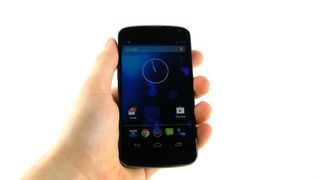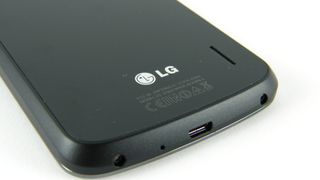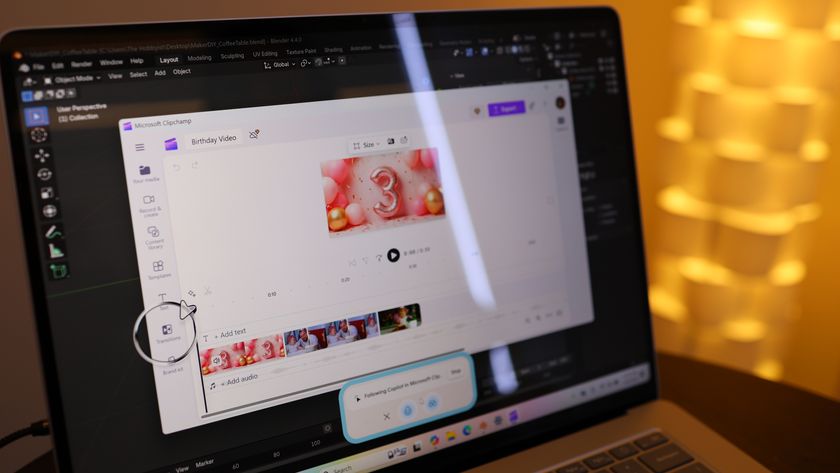TechRadar Verdict
This phone has some of the best specs around and it's fantastic value. Had it not been crippled by silly things like a paltry memory allowance and not-quite-there camera, we'd have recommended it immediately and given it a five star rating.
Pros
- +
Beautiful, elegant design
- +
Excellent screen
- +
Android 4.2
- +
Unbelievable price
Cons
- -
No expandable memory
- -
No flash internet
- -
No 4G
- -
Camera could be better
Why you can trust TechRadar
We've now got our hands on the White Nexus 4 - check out our gallery and 'review' of the new colour. We'll spoil it now... it's the same but looks a bit different.
Google's Nexus (ten points to anyone who can tell us if Nexi is the correct plural) smartphones have always set the standard when it comes to a pure Google experience.
The first Nexus One was a true geek device. Sold only through Google directly (apart from a brief flirtation with Vodafone), it never achieved massive sales. But it gave the world the true raw power of Android without the bloatware of other variants. As of January 2010, the ball was well and truly rolling.
We've had several now – and everyone, it seems, had a go: HTC, Samsung, Asus and LG – though strangely, not Motorola, which is now part of Google itself.
Some handsets we look forward to with much anticipation – only to feel deflated when we actually use them. Others, we wait for with little expectation – and they absolutely blow our socks off.
A stealth surprise. We'll lay our proverbial cards on the table here from the outset. The Nexus 4 is one of those rare devices.

LG's not had the best track record of late. Sure, we thought the Optimus 4X HD was a pretty decent offering, but too little, too late compared to what was already out there by the time LG got it to market.
And whereas LG did have good form when it came to innovation back in the day (who remembers the Chocolate, the Shine – and even the dubious widescreen BL40?), the mojo seemed to have passed.
That's not a dig at the South Koreans – far from it. But just to set the scene to show why we weren't expecting much from the Nexus 4.

Perhaps the worst kept secret since the iPhone 5, the Nexus 4 even got left in a bar in true cliché style. And from the pictures, we weren't alone in thinking it looked like a copy of the Samsung Galaxy Nexus.
The difference is, when we took the Samsung model out of its box this time last year, we thought it was nice. When we took the Nexus 4 out of its box last week, we thought it was beautiful.

Size wise, the Nexus 4 comes in at 133.9 x 68.7 x 9.1 mm – which means it is similar to its predecessor. But it is far more stunning to look at and hold.
The front is all glass in piano black. Extra tough too thanks to the Corning Gorilla Glass 2. Think iPhone 4S territory, but just a little nicer looking (we are aware that is a matter of opinion, iFans!)

The whole front is set within a dull chrome bezel and the shininess even extends to the rear of the handset, which has an attractive, though unusual sparkly pattern adorning it - although newer shipments seem to be shorn of that element now.
Think the glittery kind of jacket that you could see Cilla Black, Joan Rivers or Shirley Bassey in at an awards ceremony, and you catch our drift.
Since launch LG has updated the design very slightly on the rear of the Nexus 4, with newer handsets sporting two tiny bumps at the bottom of the phone, which elevates the handset slightly.
This means sound isn't as distorted when played through the rear speaker, plus it stops the shiny glass back of the Nexus 4 scratching on the surface it's sitting on.

At 139g, the Nexus 4 isn't the lightest handset in school – but it's just about solid enough to get away with carrying that extra weight and puts those who say Android devices look like toys firmly in their place.
The screen is invisible when off – but when it lights up, you're treated to 4.7-inches of True HD IPS Plus beauty. That's 768 x 1280 pixels with a pixel density of 318. It is razor sharp – blowing Retina out of the water and we'll venture it is one of the best we've seen on a handset.

Another reason for this is because there is such little space between the glass and the display. So where we berated the Optimus 4X HD for leaving enough room here to park a small car, the Nexus 4 leaves no gap at all.
It exudes a clarity that has to be seen to be believed. Colours look beautiful, icons and text are razor sharp and everything floats perfectly.
We find it hard to see how this could be beaten. When you're looking at icons on a black background (like in the app drawer), you can't even see the black, if that makes sense. It is so deep, that icons just float. Beneath the screen, in the centre, but hidden until needed, lies a pulsating notification light.

Another element worth pointing out here is the way the phone curves at the sides, from the main panel into the bezel. It seems to make the screen look even more realistic and beautiful. It's one of those things you really have to experience to appreciate.
Round the edges, you'll find the usual adornments. A 3.5mm headphone jack on top, volume rocker and micro SIM tray on the left, micro USB port plus a few dubious screws on the bottom, and a perfectly placed lock/unlock/power button on the upper right hand side.
It's just in that sweet spot where it's easy to press with the thumb if you're right handed and not impossible if you're a leftie.

There's no way of getting the back off – so you know what that means, peeps. No removable battery and no expandable storage. The former doesn't faze us too much since the 2,100mAh battery pack is no slouch but the lack of memory card allowance is annoying.
Yes, we know that ever since the Nexus S, expandable memory is out. Google's said that it doesn't offer it because it's confusing. But for those with lots of content who can't or don't want to stream, it's a real pain. We don't quite buy Google's argument.
As for the innards, LG has cut no corners here. Make no mistake, this is a premium handset. DC-HSDPA, the very latest iteration of Jelly Bean 4.2, a Qualcomm Snapdragon chipset, quad-core 1.5GHz processor, A-GPS with GLONASS, NFC and so forth.

But what makes this so sweet is the price. Let's just point out that sim-free, a HTC One X with similar specs will set you back around £320 (around $490/AU$475) and the Samsung Galaxy S3 can now be snapped up for £329 (around $525/AU$503).
And while last year's Galaxy Nexus will leave your wallet £299 (around $477/AU$458) lighter, this brand new model, the Nexus 4 is priced – almost unbelievably – at £239 ($299/AU$349) for the 8GB version and £279 ($349/AU$480) for 16GB. Yes, the newer Nexus is cheaper than the year old Nexus. Word!
We can't overestimate just how revolutionary this is and it leaves us open-mouthed at how Google is doing this. Either it's selling the Nexus 4 at a loss – or the mark-up on handsets is now shown up as being ridiculously high. Whichever it is, it means the Nexus 4 has a distinct advantage over the competition.

Bizarrely, in the UK Google promised O2 that it can sell the Nexus 4 as an exclusive for the first month. We can't understand why – especially because you could end up paying £800 for the device over the course of the contract, but there are loads of these all over Google Play Store these days.
Virgin Mobile has also joined the Nexus 4 brigade by offering LG's handset on a contract - but with prices starting at £31 a month, it's not going to be a decent way to get a cheap Google phone in your hand.
Most people with sense (and a bit of spare cash) will buy the Nexus SIM-free and get themselves a cheap as chips SIM-only plan. The only downside is that LG has been a little slow on actually making these devices, despite Google subsidising the cost of the handset to the tune of hundreds of pounds per device.

I tried Copilot Vision, and it could change how you use Windows forever

I took the rear-windowless Polestar 4 on a three-day road trip – here’s why ditching the back glass was a good (and bad) idea

This mini PC has a 7-inch display that can apparently run Windows and an AMD Ryzen 9 CPU, but there's even better options to be had











